Toshiba Portege R835: Less Ultra, More Notebook
by Dustin Sklavos on March 30, 2012 11:35 AM EST- Posted in
- Laptops
- Intel
- Toshiba
- Sandy Bridge
- Notebooks
Battery Life
Where the Toshiba Portege R835 really benefits from Sandy Bridge and excels over its predecessor is in running time on the battery. Toshiba lists the battery life for the R835 as approximately nine hours, a hurdle we were actually able to clear pretty easily at idle.
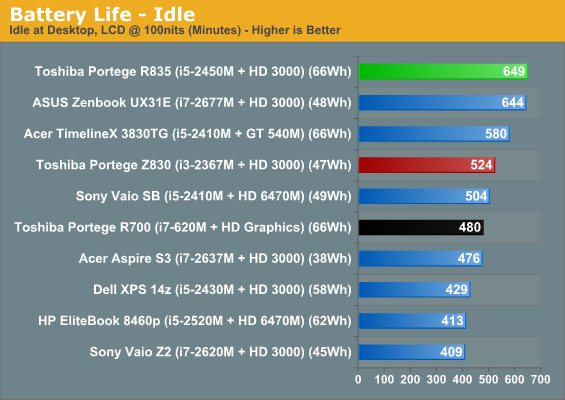
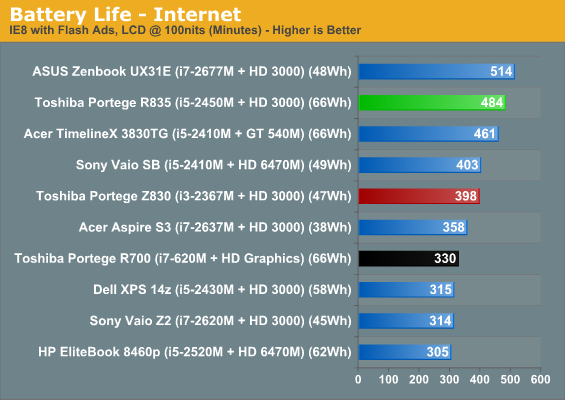
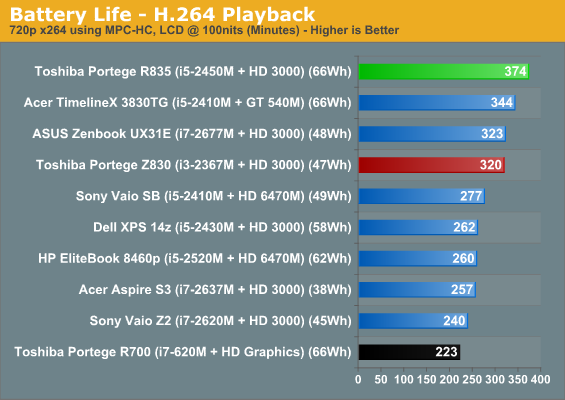
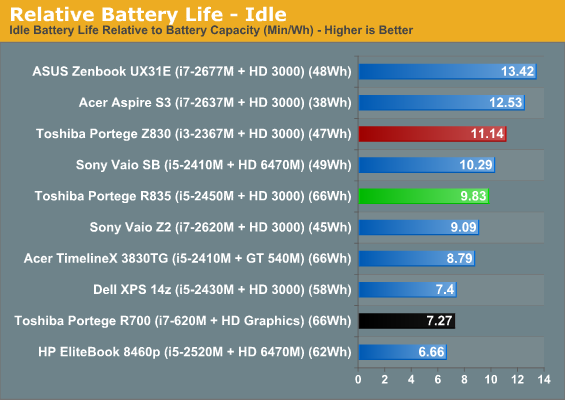
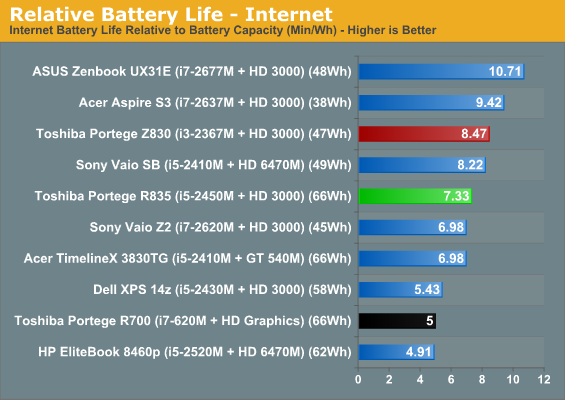
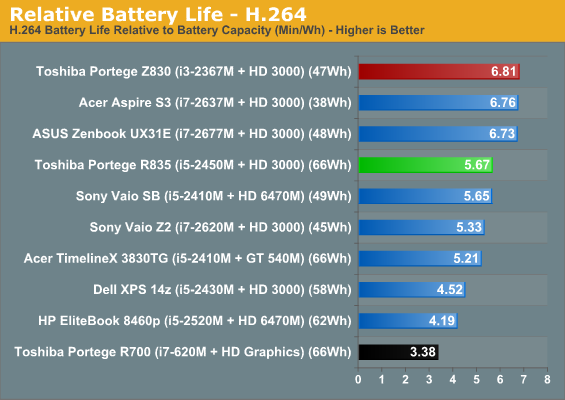
From our test results it's reasonable to assume an end user could hit that nine hour mark if they're willing to sacrifice some display brightness, or if they turn off the wireless once in a while. The Portege R835 also again demonstrates something we've been aware of for a while now: Sandy Bridge is just plain more power efficient than Arrandale. Given we're essentially looking at an updated R700, Sandy Bridge vs. Arrandale ends up with Sandy Bridge offering 35% more idle battery life, 47% more Internet battery life, and a massive 68% more video playback battery life. I makes us wonder how much further Intel can take things with Ivy Bridge, but we'll find out soon enough.
Heat and Noise
Fortunately, the high-pitched whine of the fan noise in many ultrabooks and particularly machines like Sony's Vaio Z2 isn't replicated in the Portege R835; Toshiba's notebook, even under heavy load, isn't actually that obtrusive.

Ignoring HWMonitor misreading the CPU model number, we can see there's a very good reason why fan noise isn't a huge issue with the Portege R835: the processor is basically cooking itself. This is a situation that's basically inexcusable and prevents me from making a recommendation full-stop. I was concerned thermals would prevent the i5-2450M from hitting its turbo clocks consistently after seeing these results, but apparently it's not an issue...the chip just runs very hot in this notebook.
While it's true modern processors take care of themselves to avoid burning out, I still can't help but feel like these kinds of thermals are a warranty call waiting to happen. Once dust starts accumulating in that fan it's going to be game over. This heat doesn't directly translate to the keyboard or the bottom surface of the notebook, but it's there and worthy of concern. Anecdotally, we've seen several older laptops that erred on the side of silence rather than cooling that developed serious issues over time—Jarred in fact just helped someone with a Core 2 Duo laptop that was shutting down and running horribly slow thanks to dust buildup. If you do buy a laptop like this, we definitely recommend regular dust cleanouts with compressed air, at least a couple times per year.










81 Comments
View All Comments
MooseMuffin - Friday, March 30, 2012 - link
I actually have this laptop and I replaced the HDD with a SSD within two weeks of owning it.TrackSmart - Friday, March 30, 2012 - link
Ditto. I have the R700 (basically the same laptop). I installed a small SSD and put the original hard disk in the optical drive bay. A nice compromise that wouldn't be possible in an ultrabook.Now if they would only start making decent screens on these things...
agent2099 - Friday, March 30, 2012 - link
That is really the way to go. Manufactures charge a huge premium for adding ssds.steven75 - Friday, March 30, 2012 - link
Anandtech isn't a site for "most people", it's a site for tech enthusiasts. They are right to recommend SSDs over HDDs at this point in time. The cost-to-benefit ratio is very much in favor of SSDs.pdjblum - Friday, March 30, 2012 - link
This is a crapple-centric site that used to be an enthusiast site. Now Anand and all his sheep primarily use crapple and measure everything against it.TrackSmart - Friday, March 30, 2012 - link
I have no love for apple, but I don't see the problem here. If you are not willing to buy a laptop with a crappy screen and and less than stellar build quality, that doesn't leave you with many other options outside of Apple, a few very expensive models from Sony, and the HP Envy series (which doesn't always have the display upgrade available). Like it or not, Apple sells a lot of laptops and also sets a pretty high bar for overall build quality, which is why they are so often used as a benchmark for comparison.Snotling - Saturday, March 31, 2012 - link
Dell XPS also have a few decent offers...frostyfiredude - Friday, March 30, 2012 - link
Are you saying Anand's standards have gone up because they use Apple machines now?If so, I don't see how that is an issue.
You have to admit that Apple makes excellent machines, hence why they are the reference; they use some of the best displays, two of the best chassis designs, consistently excellent battery life, and they do all the little things like keyboards and trackpads right every time.
ImSpartacus - Saturday, March 31, 2012 - link
Yup. I wish I could buy a PC, but Macbooks are way too damn good (the TRACKPAD). And bootcamp works well enough, so it's little inconvenience.MrSpadge - Saturday, March 31, 2012 - link
Sure, the average buyer just goes for "cheap enough", maybe with a little extra. But that doesn't mean this is good or the right way for them. Instead of upgrading this Toshiba with 2 GB more RAM for 50$ it should have gotten a 128 GB SSD for maybe 100$+. That would have turned it into a much more usable machine (for most purposes.. external storage is still your friend).